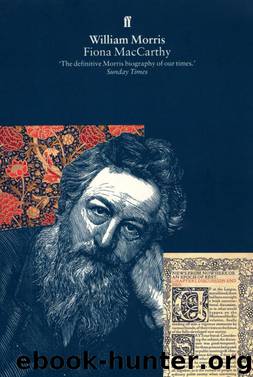William Morris by Fiona MacCarthy

Author:Fiona MacCarthy [Fiona MacCarthy]
Language: eng
Format: epub
ISBN: 9780571265831
Publisher: Faber & Faber
Published: 2014-02-08T16:00:00+00:00
Morris regarded tapestry as the summit of what could be achieved in textiles. He saw it as essentially wall decoration, ‘a mosaic of pieces of colour made up of dyed thread’. Morris liked its exactness: in a tapestry, he argued, ‘nothing vague or indeterminate is possible’. He admired the depth of tone, the richness of colour and the subtle variations of tone feasible in tapestry; and especially he warmed to ‘that crispness and abundance of beautiful detail’ characteristic of mediaeval embroidery and weaving. It was this vividness of detail he had noticed when he first saw the Bayeux Tapestry. To Morris the mediaeval tapestry was the equivalent of a Chaucer poem, precise in its narrative, human in its range of reference, eloquent, alive. Tapestry, like stained glass, was a story-telling medium. It was public art, immediately accessible. Morris loved woven pictures, even as a child.
He had kept these ambitions in abeyance until the Firm’s carpet making was progressing satisfactorily. To his annoyance Queen Victoria had preempted him. In 1875 The Windsor Tapestry Works had been established, under the Queen’s patronage, on royal land at Old Windsor. Morris complained to Wardle: ‘The Widow Guelph has been enticing customers from us and has got an order for tapestry that ought to have been ours.’ However, by the end of 1877 he and Wardle had entered into practical discussions about plans for making tapestry. It appears that Wardle’s aims were more commercial than artistic. Perhaps he saw a Leek equivalent of the royal works at Windsor. Morris felt this would be pointless: ‘Let’s clear off what you say about the possibility of establishing a non-artistic manufactory: you could do it of course; ’tis only a matter of money and trouble: but, cui bono?’
Morris’s own plans were artistically purist and once again he had no obvious points of reference. As he told Aymer Vallance in an interview on ‘The Revival of Tapestry Weaving’ in The Studio, the looms in use at Windsor, which Morris had investigated, were horizontal looms operated by a weaver working opposite the picture he was making. Morris considered this method mechanical and artistically limiting. He intended to pursue the high-warp or haute-lisse method, as used to make the mediaeval Flemish tapestries, in which the weaver works from behind the tapestry, watching the progress of the picture through a mirror. This method gave the weaver more creative freedom. Morris also liked to think that Penelope and other ancient tale-tellers had created picture stories on just such an antique loom. Though the high-warp loom was still in use in Paris, at the Gobelins works where Morris much despised its products, there was no more local source of information and Morris, once again, fell back on ancient technical manuals, in this case a book from the Arts et métiers series published in eighteenth-century France.
Morris knew in theory the qualities he looked for in a maker of tapestries. He had listed them out in a letter he sent Wardle:
1. General feeling for art, especially for its decorative side.
Download
This site does not store any files on its server. We only index and link to content provided by other sites. Please contact the content providers to delete copyright contents if any and email us, we'll remove relevant links or contents immediately.
On Writing A Memoir of the Craft by Stephen King(4863)
The Doodle Revolution by Sunni Brown(4689)
A Simplified Life by Emily Ley(4099)
Mummy Knew by Lisa James(3634)
Marijuana Grower's Handbook by Ed Rosenthal(3623)
Better Homes and Gardens New Cookbook by Better Homes & Gardens(3526)
Figure Drawing for Artists by Steve Huston(3384)
Paper Parties by Erin Hung(3371)
Draw Your Day by Samantha Dion Baker(3290)
The Genius of Japanese Carpentry by Azby Brown(3226)
Japanese Design by Patricia J. Graham(3112)
The Code Book by Simon Singh(3077)
Dangerous Girls by Haas Abigail(2980)
Lions and Lace by Meagan Mckinney(2925)
The Curated Closet by Anuschka Rees(2915)
How to Make Your Own Soap by Sally Hornsey(2830)
The Checklist Manifesto by Atul Gawande(2779)
The Wardrobe Wakeup by Lois Joy Johnson(2733)
Zero to Make by David Lang(2726)
